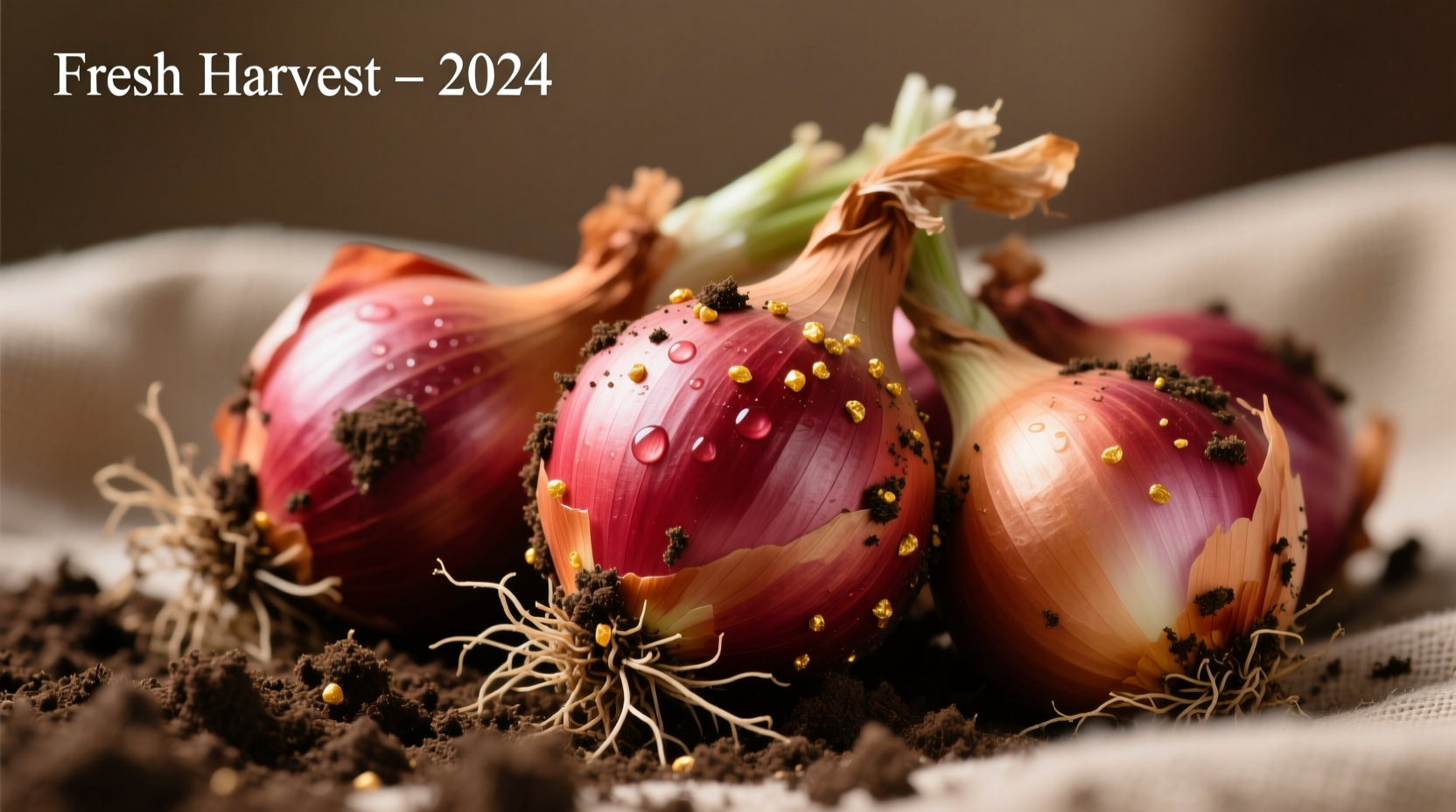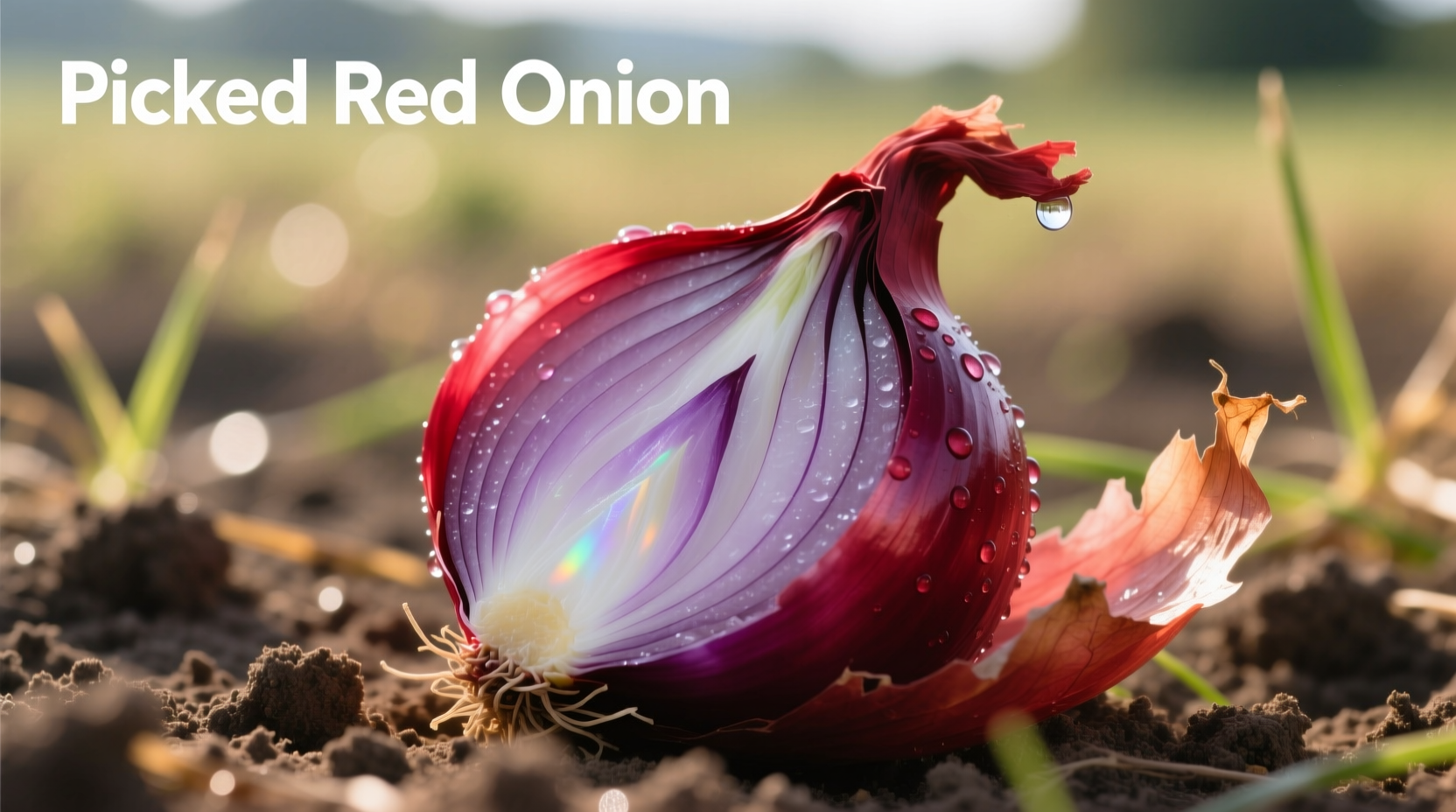Discover exactly what makes freshly harvested red onions special and how to maximize their culinary potential. Whether you're selecting them at the farmers market, storing your garden bounty, or deciding how to use them in your next dish, this guide delivers practical, chef-tested insights you can apply immediately.
What Sets Picked Red Onions Apart
When red onions are properly harvested at peak maturity, they offer distinctive qualities that differentiate them from store-bought varieties sitting on shelves for weeks. The moment you slice into a recently picked red onion, you'll notice the vibrant purple rings radiating through crisp, juicy flesh. Unlike older onions that develop dry layers, freshly harvested specimens maintain optimal moisture content while delivering that signature sweet-yet-sharp flavor profile that makes them culinary favorites.
According to the USDA Agricultural Research Service, red onions contain approximately 20% more anthocyanins than other common varieties, those powerful antioxidants responsible for their rich color and many health benefits. This concentration peaks when onions are harvested at the right maturity stage.
Harvesting Timeline: From Field to Freshness
Understanding when red onions reach optimal harvest conditions explains why "picked" matters. Here's the typical progression:
- Early Summer: Onion tops grow vigorously, directing energy to bulb development
- Mid-July: Tops begin to yellow and fall over naturally (the critical harvest signal)
- Late July-Early August: Ideal harvesting window when 50-75% of tops have fallen
- Immediately After Harvest: Onions undergo 7-10 day curing process in dry, shaded area
- 3 Weeks Post-Harvest: Peak flavor development as sharp compounds mellow slightly
Skipping the proper curing stage—often the case with commercial operations prioritizing speed—results in onions that don't store well and lack flavor complexity. Home gardeners who harvest too early end up with smaller bulbs that don't develop full sweetness.
How to Identify Recently Picked Red Onions
Whether you're at a farmers market or checking your garden harvest, look for these freshness indicators:
- Skin condition: Deep, uniform purple color without green sprouts or soft spots
- Neck tightness: Completely dry, tight neck with no moisture or green growth
- Weight: Heavy for their size indicating high moisture content
- Smell: Clean, fresh onion scent without sour or fermented notes
- Feel: Firm bulbs that don't yield to gentle pressure
Commercially distributed red onions often show signs of aging like loose, papery skin and dry necks. Recently picked specimens maintain more moisture in their outer layers and feel substantially heavier.
Red Onion Comparison: Freshly Picked vs. Store-Bought
| Characteristic | Freshly Picked Red Onions | Typical Store-Bought |
|---|---|---|
| Harvest to Purchase Time | 1-4 weeks | 2-6 months |
| Moisture Content | 85-90% | 70-75% |
| Flavor Profile | Bright, balanced sweet-sharp | Muted, often overly sharp |
| Storage Life | 2-3 months properly stored | 1-2 months |
| Best Culinary Uses | Raw applications, quick cooking | Longer cooking, caramelizing |
Proper Storage Techniques for Maximum Freshness
How you store your picked red onions dramatically affects their longevity and flavor. Follow these professional chef recommendations:
- Cure properly first: Allow onions to dry in a shaded, well-ventilated area for 7-10 days until necks are completely dry and outer skins rustle
- Trim carefully: Cut tops to 1 inch after curing—never before, as this invites rot
- Store in ideal conditions: Keep in mesh bags or baskets in cool (45-55°F), dark, dry place with good air circulation
- Avoid common mistakes: Never store near potatoes (they emit moisture-accelerating gases) or in plastic bags (traps moisture)
Refrigeration extends shelf life but alters texture—only refrigerate if you've cut the onion. Whole, properly stored red onions maintain peak quality for 2-3 months, while refrigerated cut pieces last 7-10 days in airtight containers.

Culinary Applications: Where Fresh Red Onions Shine
The unique properties of recently picked red onions make them ideal for specific applications where their vibrant color and balanced flavor can shine:
- Raw preparations: Their milder heat profile compared to storage onions makes them perfect for salads, salsas, and garnishes without excessive tearing
- Pickling: The crisp texture holds up beautifully in quick pickles, absorbing flavors while maintaining structure
- Grilling: Slice 1/2-inch thick, brush with oil, and grill for sweet, caramelized results that retain shape
- Quick sautés: Cook just until translucent to maintain their distinctive purple hue in dishes
Professional chefs particularly value freshly picked red onions for raw applications where their superior moisture content and balanced flavor create more vibrant, complex results than older store-bought varieties. As noted in University of Minnesota Extension research, the sulfur compounds responsible for onion flavor continue to develop during proper storage, reaching optimal balance at about 3 weeks post-harvest.
When to Choose Red Onions Over Other Varieties
Understanding the specific culinary contexts where red onions excel helps you make better ingredient decisions:
- Choose red onions when: You want vibrant color in raw dishes, need a balanced sweet-sharp flavor for salsas, or desire mild onion presence in salads
- Choose yellow onions when: Making soups, stews, or dishes requiring long cooking where color isn't important
- Choose white onions when: Authentic Mexican cuisine requires their sharper, cleaner flavor profile
- Limit red onion use when: Cooking for extended periods (color fades) or when sharp onion flavor is undesirable
Food science research from USDA National Institute of Food and Agriculture confirms that red onions contain different proportions of flavor compounds than yellow or white varieties, explaining their unique culinary behavior. Their higher sugar content makes them caramelize faster but also burn more easily if not monitored.
Common Mistakes to Avoid with Fresh Red Onions
Even experienced cooks make these frequent errors with freshly picked red onions:
- Storing in the refrigerator while whole: Cold temperatures convert onion starches to sugars too quickly, altering flavor balance
- Cutting too far in advance: Their higher moisture content means they oxidize faster than yellow onions—prepare within 30 minutes of use
- Using in long-simmered tomato sauces: Their color bleeds dramatically into surrounding ingredients
- Not adjusting cooking times: Their higher sugar content means they caramelize 25% faster than yellow onions
By understanding these specific characteristics of freshly picked red onions, you'll consistently achieve better results in your cooking while making the most of their seasonal availability.
Frequently Asked Questions
How can I tell if a red onion was recently picked rather than stored for months?
Recently picked red onions feel heavy for their size, have tight dry necks without sprouting, show vibrant deep purple skin without excessive dryness, and lack the papery outer layers common in long-stored onions. When cut, they release more moisture and have a brighter, more balanced flavor compared to older specimens.
What's the best way to store freshly picked red onions from my garden?
After harvesting, cure red onions for 7-10 days in a shaded, well-ventilated area until necks are completely dry. Trim tops to 1 inch, then store in mesh bags in a cool (45-55°F), dark, dry place with good air circulation. Properly stored, they'll maintain peak quality for 2-3 months. Never store near potatoes or in plastic bags.
Why do my freshly picked red onions taste different from store-bought ones?
Freshly picked red onions contain higher moisture content and different proportions of flavor compounds that haven't fully mellowed through storage. They typically offer a brighter, more balanced sweet-sharp flavor compared to store-bought onions which have often been in storage for months, causing flavor compounds to concentrate and moisture to decrease. The optimal flavor balance develops about 3 weeks after proper curing.
Can I use freshly picked red onions immediately after harvesting?
While you can use them immediately, waiting 3-4 weeks after proper curing yields significantly better results. Freshly harvested onions need curing time for their outer layers to dry completely and for flavor compounds to balance. Using uncured onions results in excess moisture that affects cooking performance and a sharper, less complex flavor profile that hasn't had time to mellow.











 浙公网安备
33010002000092号
浙公网安备
33010002000092号 浙B2-20120091-4
浙B2-20120091-4